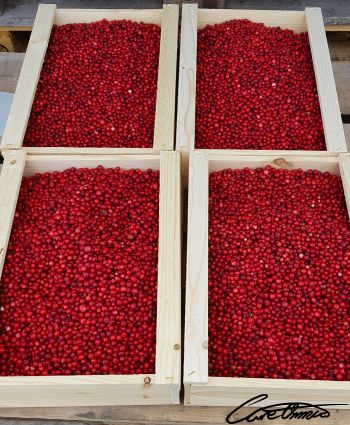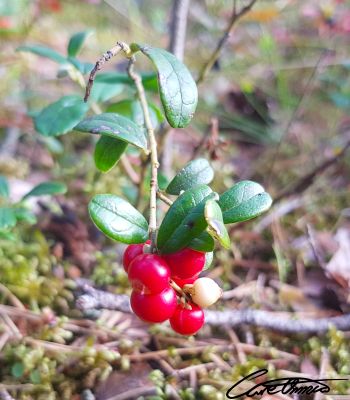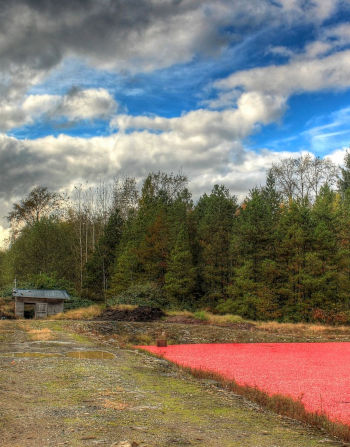We are reader-supported. When you buy through links on our site, we may earn an affiliate commission. Learn more
Where Do Lingonberries Come From? What About Their History?

Lingonberries have a long history!
There's a common misconception that they only grow in Scandinavia.
Fortunately that's wrong. You can actually find them in more than 20 countries!
It's no secret; we love berries and think that it's a fantastic berry.
But when it came to the history and the origins of lingonberries I found myself at a loss (before I wrote this article).
Its ranked by many, including us at Care Omnia, as a super berry because of its nutrients and health benefits.
So what about its origin then? Where do lingonberries come from? What's its history?
Lingonberries truly have a long history. There are old texts which document the use of lingonberries in Scandinavia.
About a hundred years ago lingonberries wasn't just a side dish but the main course.
Lingonberries are found in more than 20 countries, but the history of the berry is scattered.
Let's dive into its origin and make some sense out of it!
Table of Contents
What Are Lingonberries?

Lingonberries are red small berries that grow on bushes that are between 2 to 16 inches high (5 to 40 cm).
The bush retains its leaves all year round, which means that the lingonberry is an evergreen bush.
In the summer the bushes get small white bell-shaped flowers, that in the fall turns into small red berries.
Lingonberries grow wild in forests in the Northern hemisphere.
Lingonberries are very common in Scandinavia and especially in Sweden where they are extra popular to pick.
This is because of Swedish law that permits people to pick the berries under the “right of public access”.
Lingonberries suffer from warm weather
Lingonberries don't like warm weather.
If the summer is too hot the harvest will suffer.
The bush might have trouble with warm weather but it's a champion when it comes to the cold. It has no trouble thriving in degrees as low as -40° F (-40° C).
Lingonberries are hard to cultivate
Lingonberries are rarely cultivated.
But you can find cultivation sites in the Netherlands, Germany and North America where lingonberries has been noted for its health effects and good taste.
So the cultivation of lingonberries grows in size every year.
Lingonberries are known by a lot of different names
- Cowberry
- Dry ground cranberry
- Foxberry
- Mountain cranberry
- Northern mountain cranberry
- Partridgeberry
- Red whortleberry
- Rock cranberry
- Wolfberry
History Of Scandinavian Lingonberries
The written history of lingonberries goes back to as early as the Middle Ages.
Reading through old texts from Scandinavia we found that lingonberries were very common and quite important, especially for the poor, in the past.
Lingonberries has something that enables it to be stored for a long time, without additives, namely benzoic acid.
Benzoic acid is a potent natural preservative.
All you had to do to store lingonberries was to put the berries in some kind of container, pour in water and put on a lid.
This made it possible for you to store the lingonberries for months.
This was called “vattlingon”. You can translate the name to “water lingonberry”.
Lingonberries were abundant, nutritious and had a long shelf-life
You can read in the texts that they ate lingonberries to all foods; like meat, fish, porridge, potato and other Scandinavian foods.
Many poor people had boiled potatoes and lingonberries as their main food throughout the 19th century.
The Lingonberry rush
In the late 19th century something similar to a gold-rush started in Sweden that was later named the "lingonberry rush”.
It was landowners who first noticed that they could make money of the berries.
Suddenly, there was an interest in buying the lingonberries.
There was a demand for the lingonberries from people who were unable to pick the berries themselves.
Merchants realized that there was a lucrative market for the berries and through cooperation with landowners transformed the common lingonberry to a more valuable resource.
In the early twentieth century the railroad was built throughout the country.
This enabled international trade and the “lingonberry rush” grew exponentially.
Germans loved Swedish lingonberries
Germans in particular were very interested in the wild lingonberries from Sweden.
To meet the growing international and domestic demand for these red super-berries landowners started hiring poor people during the picking season.
Even the nations children got an extra leave from school in September called “lingonberry leave”.
This made it possible for children to help with the picking of the lingonberries.
Picking Tool Was Put To Use
It was during this time, the late 19th century, a lingonberry picking tool was put to use.
When demand grew for the lingonberries, there was a need for a more effective way to pick the berries.
This tool was actually developed in the end of the 18th century, but had not seen a widespread use before.
The value of lingonberries and the cost of labor had to reach a certain point before it was deemed worthwhile to invest in specialized tools.
The tool itself is best described like a box with "teeth" that you rake over the lingonberry bush which are then gathered inside the box.
It was a clever tool that made the work go a lot faster.
A lot more effective than picking every little berry one by one.
The funny thing is that the berry picking tool they used, is very similar to the ones you can buy today. Today we call it a hand rake.

Before the tool was crude, bulkier and made of wood and iron. Now its more flexible, lighter and often made entirely of plastic.
The more luxurious ones have metal instead of plastic on the part that separates the berry from the bush.
If you are interested, they sell one through Amazon #ad that's perfectly suited for your next berry picking adventure.
You can of course pick other berries with this tool.
It'll, for example, do wonders for your huckleberry picking needs as well.
Take it with you next time you go out picking berries and try it out.
The Scandinavian Lingonberry Today

In Scandinavia you can't really find cultivated lingonberries.
You'd have to go to other countries to find the cultivated ones.
But despite the fact that the lingonberries aren't cultivated, it's still big business in particularly Sweden.
It is still most profitable for company's in Sweden to hire people to pick the lingonberries when it is season, instead of cultivating them.
So even if more than a century has passed, merchants are still hiring people to pick the berries in the same forests that our great-great-grandparents did.
This is because of the “right of public access”, which means that if the berries grow in the wild, regardless of who owns the land, you are free to pick as much as you like.
But you need to be careful and take care of the nature while you are doing it.
With the “right of public access” combined with the amount of lingonberries you can find during the berries season, you'll quickly realize that there is no need for cultivation in Sweden.
Lingonberries In Canada
Lingonberries grows wild in Canada but it wasn't until 2015 as they really understood how important and fantastic this berry is.
The Government of Canada wrote an article about the “lure of the lingonberry: Win-Win for Northern Agriculture and Heart Health”.
This was when they seriously started to look into the lingonberry as a new super fruit.
They start their article with “Chances are you have never heard of lingonberries“.
I really hope that is not the case anymore. I hope that everyone in Canada knows about the lingonberry, how tasty it is and all about the health benefits it can provide.
I recommend you read the article from Canada ◳.
In more recent research from Canada regarding lingonberries they're now studying the potential health benefits of lingonberries.
In their research they also say the further north you go the better the nutrient content of the lingonberries. (src ◳)
If you are interested of knowing more about the health benefits, uses, taste and what and where to buy lingonberries I recommend you go to our dedicated lingonberry section.
Where Do Lingonberries Grow Globally
The Oregon State University has mapped out where the lingonberry plant grows globally ◳.
There are generally two types of lingonberry plants.
The wild lingonberry called Vaccinium vitis-idaea.
Then there is the cultivated lingonberry which they call the European lingonberry.
The bushes are almost identical and you can't tell them apart if you had one of each in front of you.
The difference between them is where you find them, ie. where it grows.
They state in a “lingonberry production guide” that you actually can find wild lingonberries in more than 20 countries.
Lingonberries have sort of a Scandinavian mark, there is a general perception that the lingonberries are a Scandinavian berry.
But this is not the case as you can see in the map below.
The Oregon State University also wrote about the cultivation of lingonberries in their guide.
That in North America you can find cultivation plots in places like Oregon, Washington, and British Columbia. They have more than 17 acres in commercial production of lingonberries.
You can also find cultivation plots in the Netherlands, Germany and Poland.

Conclusion: Lingonberries, Loved Through History
You might have guessed it from all the articles we've written on the Lingonberry; We absolutely love it.
Can't get enough of it.
In any form, be it fresh ones or jam, or whatever you make of it.
Lingonberry juice is something that I think is fantastic. You can drink it just as it is with a cube of ice as a first-class thirst quencher or have it as a flavor enhancing drink to your meal.
Try the juice with a meat dish. It's a perfect combination.
I found the old text about the Scandinavian lingonberry history fascinating. It had to be the perfect berry because of the nutrients and the preserve capabilities that this berry has.
It's amazing that there is a documented history about the lingonberry use in Scandinavia that traces back to the middle ages.
This compared to the Canadian article where they write that their citizens probably never heard about a berry called lingonberry. I’m quite sure that the berries have grown in Canada for far longer than one might think, maybe as long as it has in Scandinavia.
Lingonberries are special! If you haven't tried it yet, go try it, you won't regret it!

